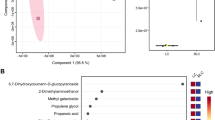Abstract
It is generally accepted that short (C2-C5) and medium (C6-C11) chain volatile fatty acids (VFAs) are among the primary causal molecules of axillary malodour. It is also widely acknowledged that malodour generation is attributable to the biotransformation of odourless natural secretions, into volatile odorous products, by cutaneous bacteria. However, little information is available on the biochemical origins of VFAs on axillary skin. In these studies, assay systems were developed to investigate the generation of VFAs from lipid substrates readily available to the bacteria resident on axillary skin. A major route to short and medium chain VFAs in the axilla was shown to be the partial catabolism of structurally unusual (e.g. methyl-branched) longer chain fatty acids by a previously uncharacterized sub-group of the Corynebacterium genus, corynebacteria (A). In contrast, corynebacteria (B) are incapable of growth on fatty acid. Structurally unusual fatty acids originate from the triacylglycerol component of sebum, and probably also apocrine sweat, by the action of bacterial lipases. Interestingly, VFA formation in the axilla is a dynamic process, with some cutaneous microorganisms, specifically micrococci and brevibacteria, capable of fully catabolizing these odorants. The results of these studies provide new understanding on the biochemical origins of VFA-based axillary malodour.
Similar content being viewed by others
References
Austin, C. & Ellis, J. 2003 Microbial pathways leading to steroidal malodour in the axilla. Journal of Steroid Biochemistry and Molecular Biology 87, 105–110.
Casey, J., Ellis, J.E., Hyliands, D., James, A.G., Mycock, G. & Taylor, D. 2000 Method of reducing or preventing malodour. US patent 6 162 422 (Unilever).
Casey, J., James, A.G., Ellis, J.E., Mycock, G. & Taylor, D. 2001 Method of reducing or preventing malodour. US patent 6 171 582 (Unilever).
Dommes, P., Dommes, V. & Kunau, W.-H. 1983 b-Oxidation in Candida tropicalis. Journal of Biological Chemistry 258, 10846–10852.
Gower, D.B., Holland, K.T., Mallet, A.I., Rennie, P.J. & Watkins, W.J. 1994 Comparison of 16-androstene steroid concentrations in sterile apocrine sweat and axillary secretions: interconversions of 16-androstenes by the axillary microflora – a mechanism for axillary odour production in man? Journal of Steroid Biochemistry and Molecular Biology 48, 409–418.
Holland, K.T. 1993 Nutrition of cutaneous resident microorganisms. In The Skin Microflora and Microbial Skin Disease, ed. Noble, W.C. pp. 33–72. Cambridge: Cambridge University Press. ISBN 0-521-40198-4.
Labows, J.N., McGinley, K.J. & Kligman, A.M. 1982 Perspectives on axillary odor. Journal of the Society of Cosmetic Chemists 34, 193–202.
Leyden, J.J., McGinley, K.J., Holzle, E., Labows, J.N. & Kligman, A.M. 1981 The microbiology of the human axilla and its relationship to axillary odor. Journal of Investigative Dermatology 77, 413–416.
Massey, L.K., Sokatch, J.R. & Conrad, R.S. 1976 Branched-chain amino acid catabolism in bacteria. Bacteriological Reviews 40, 42–54.
Moat, A.G. & Foster, J.W. 1988 Carbohydrate metabolism and energy production. In Microbial Physiology, 2nd edn. pp. 118–220. New York: John Wiley & Sons.
Natsch, A., Gfeller, H., Gygax, P., Schmid, J. & Acuna, G. 2003 A specific bacterial aminoacylase cleaves odorant precursors secreted in the human axilla. Journal of Biological Chemistry 278, 5718–5727.
Nicolaides, N. 1974 Skin lipids: their biochemical uniqueness. Science 186, 19–26.
Nicolaides, N. & Apon, J.M.B. 1977 The saturated methyl branched fatty acids of adult human skin surface lipid. Biomedical Mass Spectrometry 4, 337–347.
Petersen, L.J. 1999 Interstitial lactate levels in human skin at rest and during an oral glucose load: a microdialysis study. Clinical Physiology 19, 246–250.
Parekh, J.C. 2002 Axillary odor: its physiology, microbiology and chemistry. Cosmetics and Toiletries 117, 53–62.
Pirnik, M.P. 1977 Microbial oxidation of methyl branched alkanes. CRC Critical Reviews in Microbiology 5, 413–422.
Spielman, A.I., Zeng, X-N., Leyden, J.J. & Preti, G. 1995 Proteinaceous precursors of human axillary odor: isolation of two novel odor-binding proteins. Experientia 51, 40–47.
Taylor, D., Daulby, A., Grimshaw, S., James, G., Mercer, J. & Vaziri, S. 2003 Characterisation of the microflora of the human axilla. International Journal of Cosmetic Science 25, 137–145.
Thierry, A., Maillard, M-B. & Yvon, M. 2002 Conversion of L-leucine to isovaleric acid by Propionibacterium freudenreichii TL 34 and ITGP23. Applied and Environmental Microbiology 68, 608–615.
Zeng, C., Spielman, A.I., Vowels, B.R., Leyden J.J., Biemann, K. & Preti, G. 1996 A human axillary odorant is carried by apolipoprotein D. Proceedings of the National Academy of Sciences USA 93, 6626–6630.
Zeng, X-N., Leyden, J.J., Lawley, H.J., Sawano, K., Nohara, I. & Preti, G. 1991 Analysis of characteristic odors from human male axillae. Journal of Chemical Ecology 17, 1469–1492.
Author information
Authors and Affiliations
Rights and permissions
About this article
Cite this article
James, A., Casey, J., Hyliands, D. et al. Fatty acid metabolism by cutaneous bacteria and its role in axillary malodour. World Journal of Microbiology and Biotechnology 20, 787–793 (2004). https://doi.org/10.1007/s11274-004-5843-8
Issue Date:
DOI: https://doi.org/10.1007/s11274-004-5843-8




